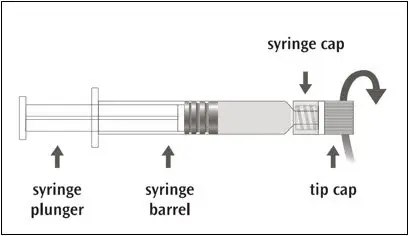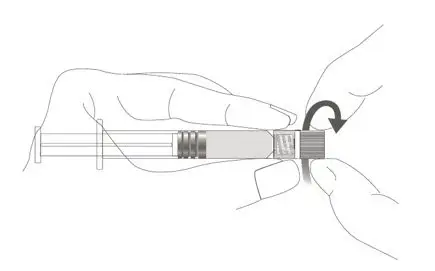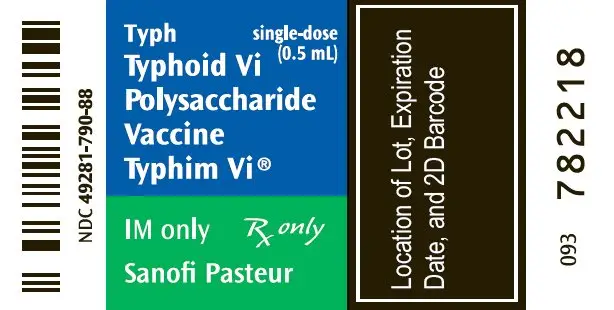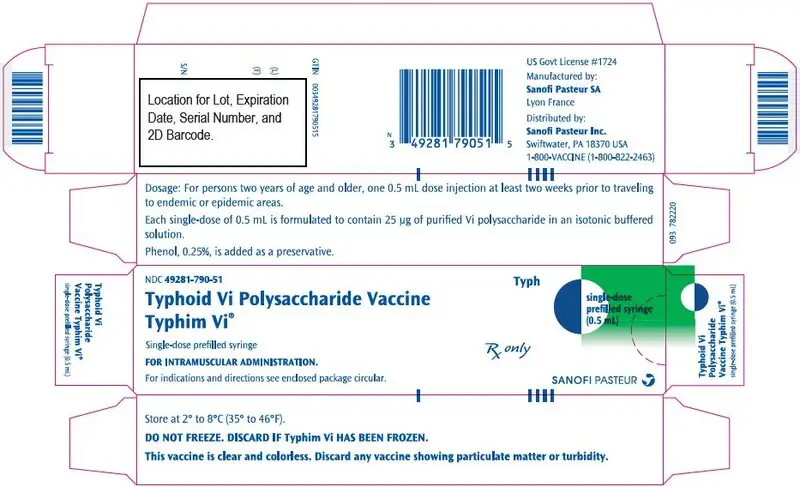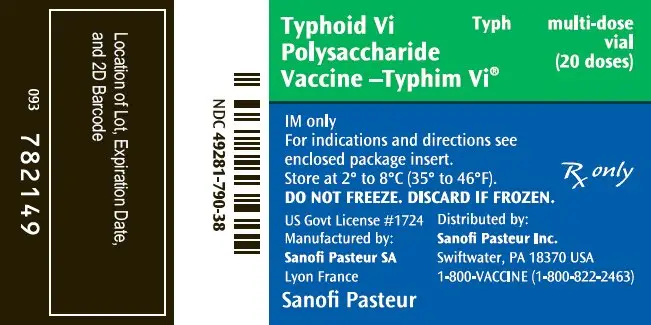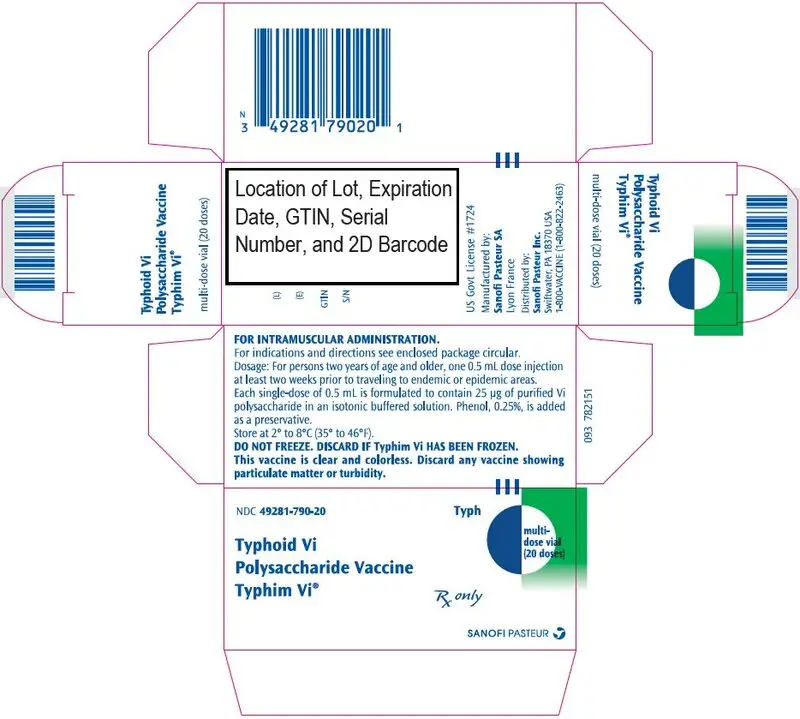Drug Detail:Typhim vi (Typhoid vaccine (inactivated), injection [ tye-foid-vax-een ])
Drug Class: Bacterial vaccines
TYPHIM Vi - Clinical Pharmacology
Typhoid fever is an infectious disease caused by S typhi. Humans are the only natural host and reservoir for S typhi; infections result from the consumption of food or water that has been contaminated by the excretions of an acute case or a carrier. S typhi organisms efficiently invade the human intestinal mucosae ultimately leading to bacteremia; following a typical 10- to 14-day incubation period, a systemic illness occurs. The clinical presentation of typhoid fever exhibits a broad range of severity and can be debilitating. Classical cases have fever, myalgia, anorexia, abdominal discomfort and headaches; the fever increases step-wise over a period of days and then may remain at 102°F to 106°F over 10 to 14 days before decreasing in a step-wise manner. Skin lesions known as rose spots may be present. Constipation is common in older children and adults, while diarrhea may occur in younger children. Among the less common but most severe complications are intestinal perforation and hemorrhage, and death. The course is typically more severe without appropriate antimicrobial therapy. The case fatality rate was reported to be approximately 10% to 20% in the pre-antibiotic era. (1) (2) (3) During the period of 1983 to 1991 in the US, the case fatality rate reported to the Centers for Disease Control and Prevention (CDC) was 0.2% (9/4010). (4) Infection of the gallbladder can lead to the chronic carrier state.
Typhoid fever is still endemic in many countries of the world where it is predominantly a disease of school-age children and may be a major public health problem. Most cases of typhoid fever in the US are thought to be acquired during foreign travel. During the periods of 1975 to 1984 and 1983 to 1984, respectively, 62% and 70% of the cases of typhoid fever reported to the CDC were acquired during foreign travel; this compares to 33% of cases during 1967-1972. (5)
In 1992, 414 cases of typhoid fever were reported to the CDC. Of these 414 cases, 1 (0.2%) case occurred in an infant under one year of age; 77 (18.6%) cases occurred in persons one to nine years of age; 81 (19.6%) cases occurred in persons 10 to 19 years of age; 251 (60.6%) cases occurred in individuals ≥20 years of age; the age was not available for 4 (1%) cases. One death was reported in 1991. (4) Domestic surveillance could underestimate the risk of typhoid fever in travelers since the disease is unlikely to be reported for persons who received diagnosis and treatment overseas. (6)
Approximately 2% to 4% of acute typhoid fever cases develop into a chronic carrier state. The chronic carrier state occurs more frequently with advanced age, and among females than males. (2) (7) These non-symptomatic carriers are the natural reservoir for S typhi and can serve to maintain the disease in its endemic state or to directly infect new individuals. Outbreaks of typhoid fever are often traced to food handlers who are asymptomatic carriers. (8)
Two formulations were utilized in studies of the Typhoid Vi Polysaccharide Vaccine. These included the liquid formulation which is identical to Typhim Vi vaccine and a lyophilized formulation.
The protective efficacy of each of these formulations of the Typhoid Vi Polysaccharide Vaccine was assessed independently in two trials conducted in areas where typhoid fever is endemic. A single intramuscular dose of 25 mcg was used in these efficacy studies. A randomized double-blind controlled trial with Typhim Vi vaccine (liquid formulation) was conducted in five villages west of Katmandu, Nepal. There were 6,908 vaccinated subjects: 3,454 received Typhim Vi vaccine and 3,454 in the control group received a 23-valent pneumococcal polysaccharide vaccine. Of the 6,908 subjects, 6,439 subjects were in the target population of 5 to 44 years of age. In addition, 165 children ages 2 to 4 years and 304 adults over 44 years of age were included in the study. The overall protective efficacy of Typhim Vi vaccine was 74% (95% confidence interval (CI): 49% to 87%) for blood culture confirmed cases of typhoid fever during 20 months of post-vaccination follow-up. (9) (10) (11)
The protective efficacy of the Typhoid Vi Polysaccharide Vaccine, lyophilized formulation, was evaluated in a randomized double-blind controlled trial conducted in South Africa. There were 11,384 vaccinated children 5 to 15 years of age; 5,692 children received the Vi capsular polysaccharide vaccine and 5,692 in the control group received Meningococcal Polysaccharide (Groups A+C) Vaccine. The protective efficacy for the Vi capsular polysaccharide (lyophilized formulation) group for blood culture confirmed cases of typhoid fever was 55% (95% CI: 30% to 70%) overall during 3 years of post-vaccination follow-up, and was 61%, 52% and 50%, respectively, for years 1, 2, and 3. Vaccination was associated with an increase in anti-Vi antibodies as measured by radioimmunoassay (RIA) and enzyme-linked immunosorbent assay. Antibody levels remained elevated at 6 and 12 months post-vaccination. (11) (12)
Because of the low incidence of typhoid fever, efficacy studies were not feasible in a US population.
Controlled comparative efficacy studies of Typhim Vi vaccine and other types of typhoid vaccines have not been performed.
An increase in serum anti-capsular antibodies is thought to be the basis of protection provided by Typhim Vi vaccine. However, a specific correlation of post-vaccination antibody levels with subsequent protection is not available, and the level of Vi antibody that will provide protection has not been determined. Also, limitations exist for comparing immunogenicity results from subjects in endemic areas, where some subjects have baseline serological evidence of prior S typhi exposure, to naive populations such as most American travelers.
In endemic regions (Nepal, South Africa, Indonesia) where trials were conducted, pre-vaccination geometric mean antibody levels suggest that infection with S typhi had previously occurred in a large percentage of the vaccinees. In these populations, specific antibody levels increased four-fold or greater in 68% to 87.5% of older children and adult subjects following vaccination. For 43 persons 15 to 44 years of age in the Nepal pilot study, geometric mean specific antibody levels pre- and 3 weeks post-vaccination were, respectively, 0.38 and 3.68 mcg antibody/mL by RIA; 79% had a four-fold or greater rise in Vi antibody levels. (9) (12)
Immunogenicity and safety trials were conducted in an adult US population. A single dose of Typhim Vi vaccine induced a four-fold or greater increase in antibody levels in 88% and 96% of this adult population for 2 studies, respectively, following vaccination (see Table 1). (10) (13)
| GEOMETRIC MEAN ANTIBODY LEVELS (mcg antibody/mL by RIA) | ||||
|---|---|---|---|---|
| N | Pre | Post (4 weeks) | % ≥4 FOLD INCREASE |
|
| (95% CI) | (95% CI) | (95% CI) | ||
| Trial 1 (1 lot) | 54 | 0.16 (0.13 to 0.21) | 3.23 (2.59 to 4.03) | 96% (52/54) (87% to 100%) |
| Trial 2 (2 lots combined) | 97 | 0.17 (0.14 to 0.21) | 2.86 (2.26 to 3.62) | 88% (85/97) (81% to 94%) |
No studies of safety and immunogenicity have been conducted in US children. A double-blind randomized controlled trial evaluating the safety and immunogenicity of Typhim Vi vaccine was performed in 175 Indonesian children. The percentage of 2- to 5-year-old children achieving a four-fold or greater increase in antibody levels at 4 weeks post-vaccination was 96.3% (52/54) (95% CI: 87.3% to 99.6%), and in the study subset of 2-year-old children was 94.4% (17/18) (95% CI: 72.7% to 99.9%). The geometric mean antibody levels (mcg antibody/mL by RIA) for the 2- to 5-year-old children and the subset of 2-year-olds were, respectively, 5.81 (4.36 to 7.77) and 5.76 (3.48 to 9.53). (10) (11)
In the US Reimmunization Study, adults previously immunized with Typhim Vi vaccine in other studies were reimmunized with a 25 mcg dose at 27 or 34 months after the primary dose. Data on antibody response to primary immunization, decline following primary immunization, and response to reimmunization are presented in Table 2. Antibody levels attained following reimmunization at 27 or 34 months after the primary dose were similar to levels attained following the primary immunization. (10) (13) This response is typical for a T-cell independent polysaccharide vaccine in that reimmunization does not elicit higher antibody levels than primary immunization. The safety of reimmunization was also evaluated in this study (see ADVERSE REACTIONS section).
| PRE-DOSE 1 | 1 MONTH | 11 MONTHS | 18 MONTHS | 27 MONTHS | 34 MONTHS | 1 MONTH POST-REIMMUNIZATION† | |
|---|---|---|---|---|---|---|---|
|
|||||||
| GROUP 1‡ | |||||||
| N Level* 95% CI | 43 0.19 (0.14-0.26) | 43 3.01 (2.22-4.06) | 39 1.97 (1.31-3.00) | ND§ | 43 1.07¶ (0.71-1.62) | ND | 43 3.04 (2.17-4.26) |
| GROUP 2# | |||||||
| N Level 95% CI | 12 0.14 (0.11-0.18) | 12 3.78 (2.18-6.56) | ND | 10 1.21 (0.63-2.35) | ND | 12 0.76¶ (0.37-1.55) | 12 3.31 (1.61-6.77) |
Adverse Reactions/Side Effects
Adverse event information is derived from clinical trials and worldwide post-marketing experience.
Data From Clinical Trials
Because clinical trials are conducted under widely varying conditions, adverse reactions rates observed in the clinical trials of a vaccine cannot be directly compared to rates in the clinical trials of another vaccine and may not reflect the rates observed in practice. The adverse reaction information from clinical trials does, however, provide a basis for identifying the adverse events that appear to be related to vaccine use and for approximating rates.
Safety of Typhim Vi vaccine, the US licensed liquid formulation, has been assessed in clinical trials in more than 4,000 subjects both in countries of high and low endemicity. In addition, the safety of the lyophilized formulation has been assessed in more than 6,000 individuals. The adverse reactions were predominately minor and transient local reactions. Local reactions such as injection site pain, erythema, and induration almost always resolved within 48 hours of vaccination. Elevated oral temperature, above 38°C (100.4°F), was observed in approximately 1% of vaccinees in all studies. No serious or life-threatening systemic events were reported in these clinical trials. (10) (11)
Adverse reactions from two trials evaluating Typhim Vi vaccine lots in the US (18- to 40-year-old adults) are summarized in Table 3. No severe or unusual side effects were observed. Most subjects reported pain and/or tenderness (pain upon direct pressure). Local adverse experiences were generally limited to the first 48 hours. (10) (11)
| REACTION | Trial 1 Placebo N = 54 | Trial 1 Typhim Vi vaccine N = 54 (1 Lot) | Trial 2 Typhim Vi vaccine N = 98 (2 Lots combined) |
|---|---|---|---|
| Local | |||
| Tenderness | 7 (13.0%) | 53 (98.0%) | 95 (96.9%) |
| Pain | 4 (7.4%) | 22 (40.7%) | 26 (26.5%) |
| Induration | 0 | 8 (14.8%) | 5 (5.1%) |
| Erythema | 0 | 2 (3.7%) | 5 (5.1%) |
| Systemic | |||
| Malaise | 8 (14.8%) | 13 (24.0%) | 4 (4.1%) |
| Headache | 7 (13.0%) | 11 (20.4%) | 16 (16.3%) |
| Myalgia | 0 | 4 (7.4%) | 3 (3.1%) |
| Nausea | 2 (3.7%) | 1 (1.9%) | 8 (8.2%) |
| Diarrhea | 2 (3.7%) | 0 | 3 (3.1%) |
| Feverish (subjective) | 0 | 6 (11.1%) | 3 (3.1%) |
| Fever ≥100°F | 0 | 1 (1.9%) | 0 |
| Vomiting | 0 | 1 (1.9%) | 0 |
No studies were conducted in US children. Adverse reactions from a trial in Indonesia in children one to twelve years of age are summarized in Table 4. (10) (11) No severe or unusual side effects were observed.
| REACTIONS | N = 175 |
|---|---|
|
|
| Local | |
| Soreness | 23 (13.0%) |
| Pain | 25 (14.3%) |
| Erythema | 12 (6.9%) |
| Induration | 5 (2.9%) |
| Impaired Limb Use | 0 |
| Systemic | |
| Feverishness* | 5 (2.9%) |
| Headache | 0 |
| Decreased Activity | 3 (1.7%) |
In the US Reimmunization Study, subjects who had received Typhim Vi vaccine 27 or 34 months earlier, and subjects who had never previously received a typhoid vaccination, were randomized to placebo or Typhim Vi vaccine, in a double-blind study. Safety data from the US Reimmunization Study are presented in Table 5. (10) (11) (13) In this study 5/30 (17%) primary immunization subjects and 10/45 (22%) reimmunization subjects had a local reaction. No severe or unusual side effects were observed. Most subjects reported pain and/or tenderness (pain upon direct pressure). Local adverse experiences were generally limited to the first 48 hours. (10) (11) (13)
| REACTION | PLACEBO (N = 32) | FIRST IMMUNIZATION (N = 30) | REIMMUNIZATION (N = 45*) |
|---|---|---|---|
|
|||
| Local | |||
| Tenderness | 2 (6%) | 28 (93%) | 44 (98%) |
| Pain | 1 (3%) | 13 (43%) | 25 (56%) |
| Induration | 0 | 5 (17%) | 8 (18%) |
| Erythema | 0 | 1 (3%) | 5 (11%) |
| Systemic | |||
| Malaise | 1 (3%) | 11 (37%) | 11 (24%) |
| Headache | 5 (16%) | 8 (27%) | 5 (11%) |
| Myalgia | 0 | 2 (7%) | 1 (2%) |
| Nausea | 0 | 1 (3%) | 1 (2%) |
| Diarrhea | 0 | 0 | 1 (2%) |
| Feverish (subjective) | 0 | 3 (10%) | 2 (4%) |
| Fever ≥100°F | 1 (3%) | 0 | 1 (2%) |
| Vomiting | 0 | 0 | 0 |
| TYPHIM VI
salmonella typhi ty2 vi polysaccharide antigen injection, solution |
||||||||||||||||||||||||||||||
|
||||||||||||||||||||||||||||||
|
||||||||||||||||||||||||||||||
|
||||||||||||||||||||||||||||||
|
||||||||||||||||||||||||||||||
|
||||||||||||||||||||||||||||||
| Labeler - Sanofi Pasteur Inc. (086723285) |
| Establishment | |||
| Name | Address | ID/FEI | Business Operations |
|---|---|---|---|
| Sanofi Pasteur | 578763542 | MANUFACTURE(49281-790) | |




